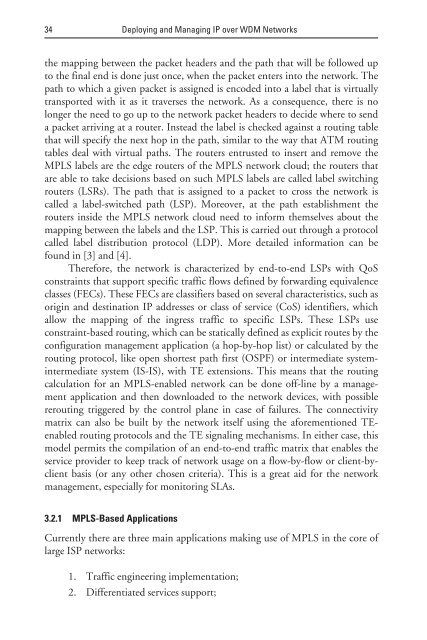deploying and managing ip over wdm networks - Index of
deploying and managing ip over wdm networks - Index of
deploying and managing ip over wdm networks - Index of
You also want an ePaper? Increase the reach of your titles
YUMPU automatically turns print PDFs into web optimized ePapers that Google loves.
34 Deploying <strong>and</strong> Managing IP <strong>over</strong> WDM Networks<br />
the mapping between the packet headers <strong>and</strong> the path that will be followed up<br />
to the final end is done just once, when the packet enters into the network. The<br />
path to which a given packet is assigned is encoded into a label that is virtually<br />
transported with it as it traverses the network. As a consequence, there is no<br />
longer the need to go up to the network packet headers to decide where to send<br />
a packet arriving at a router. Instead the label is checked against a routing table<br />
that will specify the next hop in the path, similar to the way that ATM routing<br />
tables deal with virtual paths. The routers entrusted to insert <strong>and</strong> remove the<br />
MPLS labels are the edge routers <strong>of</strong> the MPLS network cloud; the routers that<br />
are able to take decisions based on such MPLS labels are called label switching<br />
routers (LSRs). The path that is assigned to a packet to cross the network is<br />
called a label-switched path (LSP). More<strong>over</strong>, at the path establishment the<br />
routers inside the MPLS network cloud need to inform themselves about the<br />
mapping between the labels <strong>and</strong> the LSP. This is carried out through a protocol<br />
called label distribution protocol (LDP). More detailed information can be<br />
found in [3] <strong>and</strong> [4].<br />
Therefore, the network is characterized by end-to-end LSPs with QoS<br />
constraints that support specific traffic flows defined by forwarding equivalence<br />
classes (FECs). These FECs are classifiers based on several characteristics, such as<br />
origin <strong>and</strong> destination IP addresses or class <strong>of</strong> service (CoS) identifiers, which<br />
allow the mapping <strong>of</strong> the ingress traffic to specific LSPs. These LSPs use<br />
constraint-based routing, which can be statically defined as explicit routes by the<br />
configuration management application (a hop-by-hop list) or calculated by the<br />
routing protocol, like open shortest path first (OSPF) or intermediate systemintermediate<br />
system (IS-IS), with TE extensions. This means that the routing<br />
calculation for an MPLS-enabled network can be done <strong>of</strong>f-line by a management<br />
application <strong>and</strong> then downloaded to the network devices, with possible<br />
rerouting triggered by the control plane in case <strong>of</strong> failures. The connectivity<br />
matrix can also be built by the network itself using the aforementioned TEenabled<br />
routing protocols <strong>and</strong> the TE signaling mechanisms. In either case, this<br />
model permits the compilation <strong>of</strong> an end-to-end traffic matrix that enables the<br />
service provider to keep track <strong>of</strong> network usage on a flow-by-flow or client-byclient<br />
basis (or any other chosen criteria). This is a great aid for the network<br />
management, especially for monitoring SLAs.<br />
3.2.1 MPLS-Based Applications<br />
Currently there are three main applications making use <strong>of</strong> MPLS in the core <strong>of</strong><br />
large ISP <strong>networks</strong>:<br />
1. Traffic engineering implementation;<br />
2. Differentiated services support;


